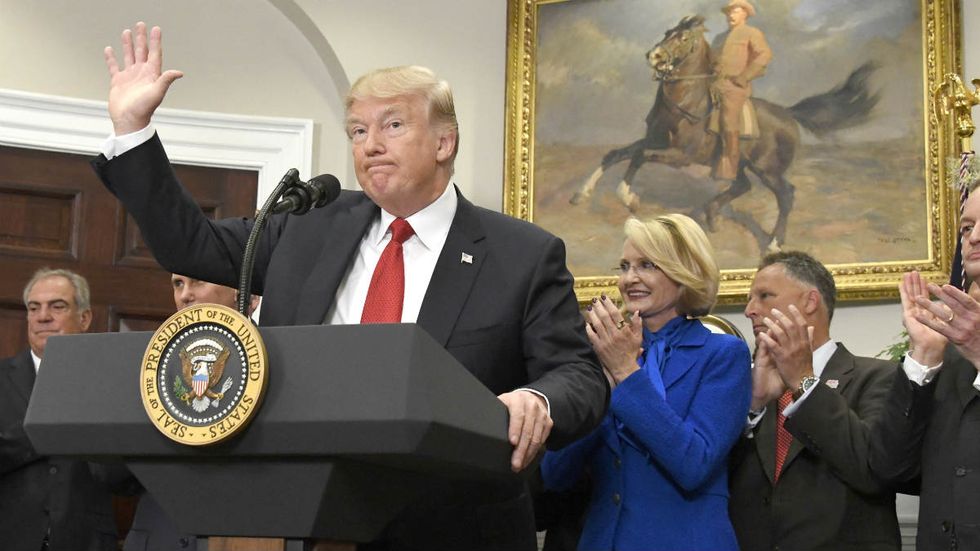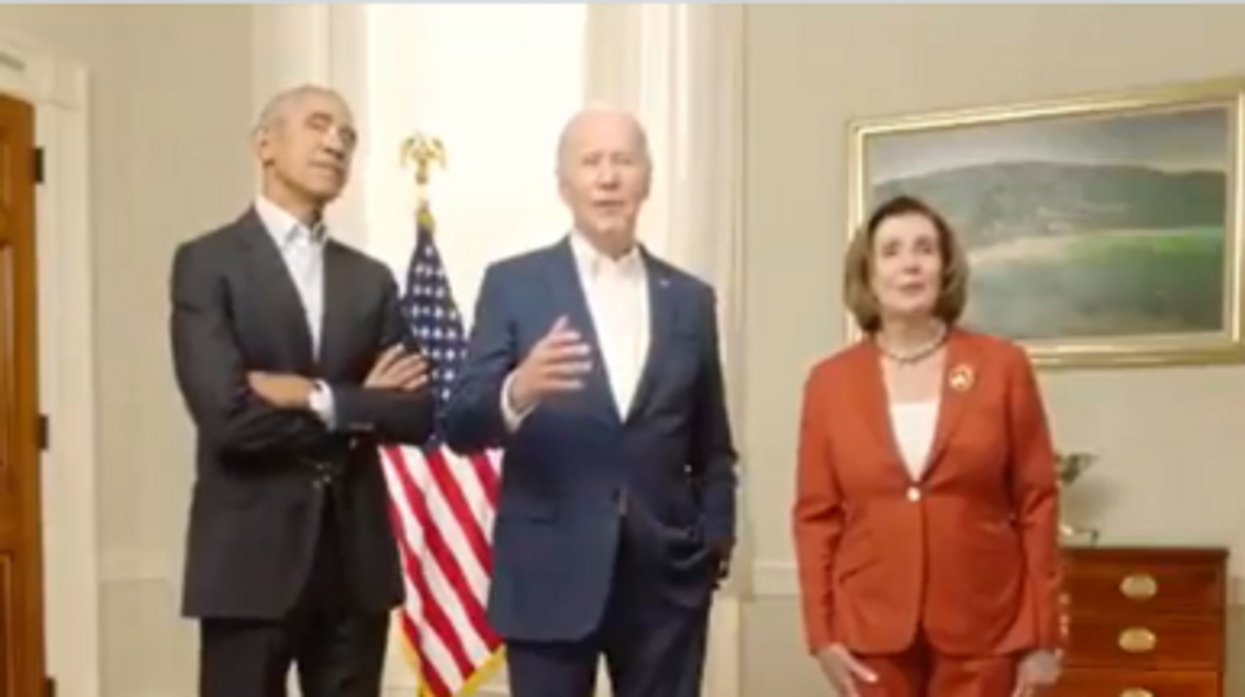
© 2024 Blaze Media LLC. All rights reserved.
Medicaid, Medicaid, Medicaid. Subsidies, subsidies, subsidies. Regulations, regulations, regulations. Bailouts, bailouts, bailouts.
This is all we hear from the sanctimonious politicians on health care.
What about those who don’t want subsidies but don’t want crushing regulations and market distortion that force them to pay the equivalent of another mortgage? Nothing Congress has attempted thus far has addressed those people. Trump’s executive order, while modest in scope and authority, is the first attempt to at least recognize the forgotten man in the health care debate.
Insurance bailouts create monopoly
To understand the utility of Trump’s virtuous, though limited, executive order on health care, we must understand what Obamacare has really done: Obamacare threw us out of our homes, locked us in a burning house, supplied fuel to the inferno, and barred the escape route for the trapped victims. Due to the limited statutory authority of the president, this executive order will not rebuild our homes or even put out the inferno, but it will offer us a narrow escape route.
Obamacare, with the illegal cost-sharing subsidies, had three major effects. First, the regulations severely raised the cost of insurance. Next, the subsidies encouraged the insurers to hike their prices even more without fear of market backlash. Third, millions who don’t get employer-based insurance but are not subsidized were scorched when Obamacare burned down their previous insurance. Worse, the requirement to purchase the insurance products has trapped those people into the system with no ability to fight back with any typical consumer leverage.
The executive order is ending the cost-sharing subsidies and opening up new competing markets. This will force companies to compete and serve as a check on endless price increases in the long run, contrary to what the political class is saying.
The best thing about the Trump order on health care was ending the illegal cost-sharing subsidies. The subsidies for individuals’ premiums — not the same thing — are already appropriated by Congress.
The details of Trump’s executive order
Trump’s executive order has three major parts.
- Association plans: It expands the definition of small businesses that are eligible for health association plans, in which they can pool resources and purchase group plans that are exempt from Obamacare regulations and other state regulations under The Employee Retirement Income Security Act of 1974 (ERISA). It is unclear how this will change the dynamic, given that individuals or non-profit associations still won’t be able to apply, due to Obamacare and state regulations. Opening up such plans for individuals would be a game-changer for competition, but Trump can’t do that through executive order. Thus, the benefit is unclear until HHS writes the regulation, within 60 days.
- Equal tax treatment for individual market plans: The order gives the IRS, HHS, and several other agencies four months to write a rule expanding the use of Health Reimbursement Arrangements (HRAs) to allow employers to use them for contributions to employees’ insurance premiums as well as out-of-pocket payments. HRAs are the employer equivalent of HSAs for individuals, in which consumers are empowered and incentivized to pay out of pocket for health care with pre-tax funds. A more revolutionary change would expand HSAs to include premium payments as well, but that would be outside the president’s authority. Expanding HRAs to include premium payments, though, seems to be within his authority because it was Obama’s IRS that made the rule in 2013 excluding premium payments from HRAs in the first place.
The important potential outcome of this change would be to encourage more small businesses to offer their employees defined contributions to their personal plans in the individual market, even if they feel they can’t afford to pay for a group plan. This is a very positive step that not only opens more of a market for individual plans but also fixes part of the “original sin” of health care, whereby people rely on group plans rather than shopping around like individual consumers the same way they do for auto and homeowner’s insurance.
It is still unclear, however, whether this would apply only to businesses with fewer than 50 employees, because under Obamacare, larger businesses must offer group plans anyway because of the employer mandate. Thus, without repealing the employer mandate, which is out of Trump’s hands, the effect of this change will be modest.
- Unregulated, short-term plans: The most significant change is the restoration of short-term, limited-duration health insurance plans (STLDIs). The other changes won’t amount to much if there is no option for consumers to escape the regulatory hell and create a new market-based corner in medical insurance with multiple choices and competition. Only a new option will make HRAs, expanded associations, and the pressure of cutting off subsidies to insurers worthwhile. This is where STLDIs come into play.
Under Obamacare, insurers were always able to offer short-term plans, defined as lasting for less than a complete year of coverage, that were exempt from all of the regulations. It was the best-kept secret of Obamacare — the narrow passage of escape from the hidden inferno for many middle-class families. However, by the time the pinch of Obamacare became really evident and people began using these plans in large numbers, Obama’s HHS limited them to three months and made them non-renewable, essentially gutting most of these plans. Trump’s order merely countermands Obama’s order and restores Obamacare to its original implementation. Thus, there can be no complaints of abusing executive authority.
This is where the potential to collapse Obamacare and offer an escape route comes into play and why the pundits are wrong about the ill effects of getting rid of the insurance bailout. Now there is a permanent check and balance on the insurance cartel. To the extent that they want to raise their premiums in response to the regulations and lack of subsidies, more and more people will take the off-ramp of the short-term plans — certainly the millions without subsidies in the individual market, but even some at the lower end of the subsidy scale and those getting increasingly pinched in the group market. It will also create a new competitive market for all those insurers who left the Obamacare exchanges to compete for the best short-term plans. And if these individual plans take off, the change to HRAs will further help, because now there will be worthy individual market plans for employers to fund that are cheaper than providing group plans.
Obviously, in the long run, we need massive systemic reform to the anti-market interventions on the supply side of health care and to cut out the third-party payer system, as well as repealing all of Obamacare’s regulations. We need the ability of individuals to purchase all health-sharing and health association plans across state lines without the individual mandate penalty for not buying cartel insurance. We need price transparency. We need to take Medicaid away from the cartel and give it straight to the people who need it. We need to end the government empowerment of the insurance cartel to price-fix the consumer into oblivion, and we must equalize treatment of alternatives to the traditional insurance model at all levels of government.
While Rand Paul suggests that Trump’s order would allow individuals, not just small businesses, to purchase association plans, I doubt HHS has the authority to do this. However, Rand Paul is right to suggest that these reforms, if implemented properly by HHS, have the potential to commence a domino effect to force broader free-market changes beyond anything congressional Republicans were offering with their phony repeal bills. It is to be hoped that the administration will follow through with these promises. The positive effects should place the pressure on Congress to enact true market-based reform.
Find out what the mainstream media won't tell you about President Trump and his administration.
Sign up to get CRTV's free White House Brief delivered right to your inbox once a day.
Want to leave a tip?
We answer to you. Help keep our content free of advertisers and big tech censorship by leaving a tip today.
Want to join the conversation?
Already a subscriber?
Blaze Podcast Host
Daniel Horowitz is the host of “Conservative Review with Daniel Horowitz” and a senior editor for Blaze News.
RMConservative
more stories
Sign up for the Blaze newsletter
By signing up, you agree to our Privacy Policy and Terms of Use, and agree to receive content that may sometimes include advertisements. You may opt out at any time.
© 2024 Blaze Media LLC. All rights reserved.
Get the stories that matter most delivered directly to your inbox.
By signing up, you agree to our Privacy Policy and Terms of Use, and agree to receive content that may sometimes include advertisements. You may opt out at any time.



